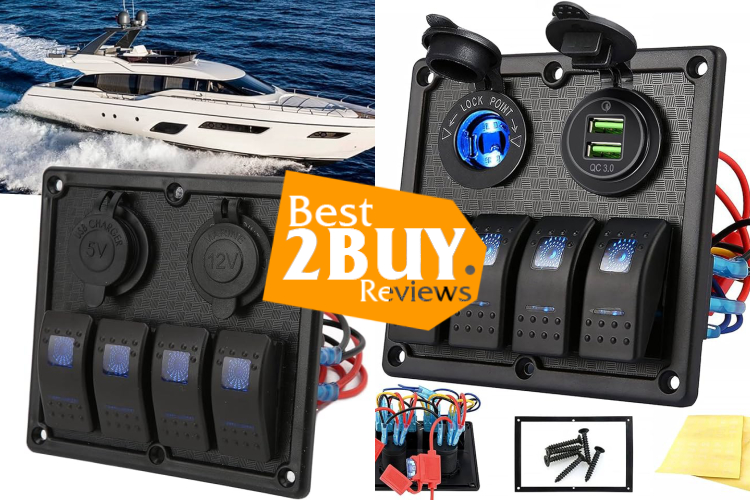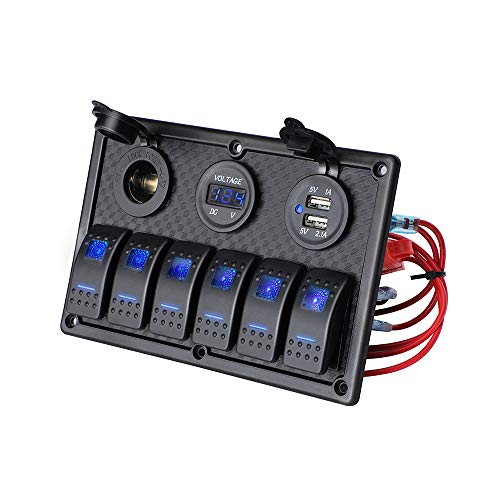How to Choose the Boat Rocker Switches
A Comprehensive Guide to Boat Rocker Switches

- 1. A Comprehensive Guide to Boat Rocker Switches
- 1.1. Understanding Boat Rocker Switches
- 1.2. Key Features
- 1.2.1. Rocker Design
- 1.2.2. Illumination
- 1.2.3. Waterproofing
- 1.2.4. Amperage and Voltage Ratings
- 1.3. Types of Boat Rocker Switches
- 1.3.1. Single-Pole Single-Throw (SPST)
- 1.3.2. Single-Pole Double-Throw (SPDT)
- 1.3.3. Double-Pole Single-Throw (DPST)
- 1.3.4. Double-Pole Double-Throw (DPDT)
- 1.4. Benefits of Boat Rocker Switches
- 1.5. Factors To Consider When Choosing Boat Rocker Switches
- 1.5.1. Durability and Weather Resistance
- 1.5.2. Waterproof Rating
- 1.5.3. Amperage and Voltage Ratings
- 1.5.4. Number of Poles and Throw Options
- 1.5.5. Backlit or Illuminated Switches
- 1.5.6. Panel Cutout Size
- 1.5.7. Switch Aesthetics and Design
- 1.6. Installation and Wiring
- 1.7. Conclusion
Rocker switches for boats play a crucial role in marine electrical systems, offering boaters a convenient and effective means to regulate various onboard devices. These switches, characterized by their uncomplicated yet efficient design, present users with an easily navigable interface for overseeing diverse functions on a boat. This article delves into the characteristics, varieties, installation procedures, and advantages of boat rocker switches.
Understanding Boat Rocker Switches
A boat rocker switch is an electrical switch featuring a pivoting actuator that oscillates to either open or close an electrical circuit. The switch is designed with user-friendly intuitiveness, making it easy for users to discern between the ON and OFF positions. These switches are frequently employed for managing lights, pumps, fans, and various other electrical accessories on boats.
Key Features
Rocker Design
The distinctive feature of these switches is their rocker-style actuator, which moves horizontally or vertically to engage or disengage the switch.
Illumination
Many boat rocker switches come with built-in LED indicators, providing visual feedback about the switch's status. This is particularly useful, especially during nighttime navigation.
Waterproofing
Given the marine environment, it is crucial for boat rocker switches to be waterproof to prevent damage from water exposure. High-quality switches often come with IP67 or IP68 ratings, ensuring reliable performance even in wet conditions.
Amperage and Voltage Ratings
Boat rocker switches are available in various amperage and voltage ratings to accommodate the diverse electrical needs of different marine devices.
Types of Boat Rocker Switches
Single-Pole Single-Throw (SPST)
The Single-Pole Single-Throw switch is the most basic type, featuring two terminals to control a single circuit. This switch is commonly used in simple applications where a device needs to be either on or off. For instance, a navigation light or a bilge pump may be controlled using an SPST switch, providing a straightforward and reliable solution.
Single-Pole Double-Throw (SPDT)
The Single-Pole Double-Throw switch, with three terminals, offers more versatility than the SPST. It can control two separate circuits, making it suitable for applications where you need to choose between two options. For example, SPDT switches are often used for selecting between two power sources or controlling navigation lights with different modes.
Double-Pole Single-Throw (DPST)
The Double-Pole Single-Throw switch features two separate circuits that are simultaneously opened or closed with a single toggle. This type of switch is ideal for applications where two devices need to be controlled together. DPST switches are commonly employed in scenarios where synchronizing the operation of two devices, such as turning on or off two lights simultaneously, is essential.
Double-Pole Double-Throw (DPDT)
Among the most versatile boat rocker switches, the Double-Pole Double-Throw switch has six terminals, allowing for the control of two independent circuits. DPDT switches find application in complex electrical systems on larger boats. They are used when the ability to choose between two options or control two separate devices independently is necessary. For instance, DPDT switches can be employed to manage the direction of a dual-speed bilge pump or to control dual navigation light configurations.
Benefits of Boat Rocker Switches
- User-Friendly Operation: The rocker design makes boat rocker switches easy to use, even in challenging conditions.
- Visual Feedback: LED indicators provide visual feedback, enhancing safety and convenience, especially in low-light situations.
- Durable and Weatherproof: Many boat rocker switches are built to withstand harsh marine environments, featuring waterproof and corrosion-resistant designs.
- Versatility: Boat rocker switches come in various types, allowing boaters to choose the right switch for their specific needs.
Factors To Consider When Choosing Boat Rocker Switches
Boat rocker switches play a crucial role in the functionality and safety of marine electrical systems. Selecting the right rocker switches for your vessel is essential for smooth navigation and a hassle-free experience on the water. In this article, we'll explore the key factors to consider when choosing boat rocker switches.
Durability and Weather Resistance
One of the primary considerations for boat rocker switches is their durability and ability to withstand harsh marine environments. The switches should be constructed with corrosion-resistant materials, ensuring they can endure exposure to saltwater, UV rays, and varying weather conditions without compromising performance.
Waterproof Rating
Given the aquatic nature of boating, it's crucial to choose rocker switches with a high waterproof rating. Look for switches with an IP (Ingress Protection) rating, which indicates the level of protection against dust and water. A higher IP rating, such as IP66 or IP67, ensures that the switches are well-protected against water splashes and immersion.
Amperage and Voltage Ratings
Different boat accessories and systems require varying levels of electrical power. Ensure that the rocker switches you choose can handle the specific amperage and voltage requirements of your boat's equipment. Exceeding these limits can lead to overheating, malfunction, or even electrical fires.
Number of Poles and Throw Options
Boat rocker switches come in various configurations, including single pole/single throw (SPST), single pole/double throw (SPDT), double pole/single throw (DPST), and double pole/double throw (DPDT). Consider the electrical requirements of your boat's systems to determine the appropriate switch configuration.
Backlit or Illuminated Switches
In low-light conditions or during nighttime navigation, illuminated rocker switches can be invaluable. Choose switches with LED indicators or backlit labels to easily locate and operate them in the dark. This feature enhances safety and convenience on your boat.
Panel Cutout Size
Ensure that the rocker switches you select fit seamlessly into your boat's electrical panel. Check the panel cutout size and choose switches that match these dimensions to avoid modification or retrofitting.
Switch Aesthetics and Design
While functionality is paramount, the aesthetics of the switches also contribute to the overall look and feel of your boat's control panel. Choose switches that complement the design of your vessel and provide a user-friendly interface.
Installation and Wiring
Installing boat rocker switches is generally a straightforward process, but it requires attention to detail to ensure safety and proper functionality. Here's a general guide:
- Disconnect Power: Before installation, disconnect the power source to avoid electrical shock.
- Choose the Right Switch: Select a switch that matches the electrical requirements of the device you are controlling.
- Cut an Opening: Cut an opening in the boat's panel where the switch will be installed, ensuring a snug fit.
- Connect Wires: Connect the power source and the device to the appropriate terminals on the switch. Follow the manufacturer's wiring diagram for guidance.
- Secure the Switch: Secure the switch in the panel opening, making sure it is firmly in place.
Conclusion
Rocker switches for boats play a vital role in ensuring the effective and secure functioning of marine electrical systems. Boasting a design that is both user-friendly and durable, along with versatile features, these switches have become a favored option for boaters seeking dependable control solutions. Whether you find yourself navigating the expansive open seas or enjoying a tranquil day on the lake, having the appropriate boat rocker switches guarantees that you maintain control effortlessly.










